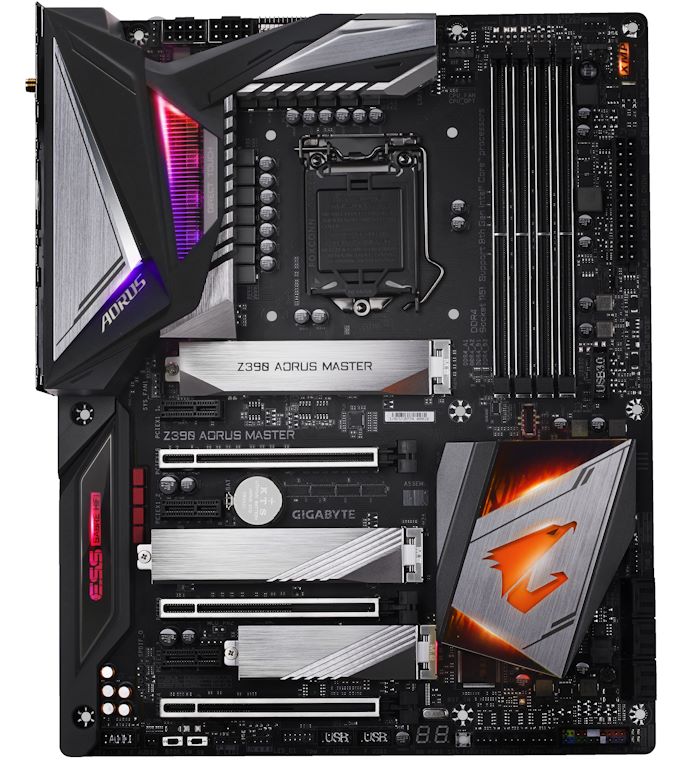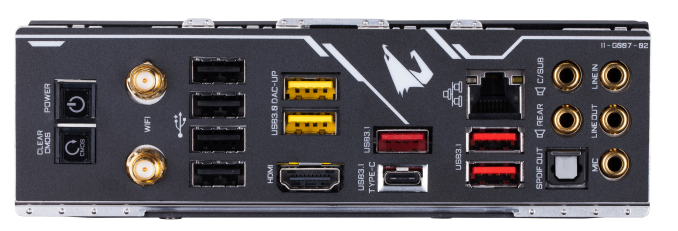Intel Z390 Motherboard Overview: 50+ Motherboards Analyzed
by Ian Cutress & Gavin Bonshor on October 8, 2018 10:53 AM EST- Posted in
- Motherboards
- Intel
- MSI
- Gigabyte
- ASRock
- EVGA
- Asus
- NZXT
- Supermicro
- Z390
GIGABYTE Z390 Aorus Master
Just like we noted in our AMD B450 launch motherboards overview, GIGABYTE has gone through a transitional period of late when it comes to branding. To make their naming scheme a little easier to decipher, the move isn't just for the benefit of users looking to distinguish between different types of motherboard, but it also allows GIGABYTE to tie in different components such as graphics cards and align them together from a marketing perspective. The new naming scheme essentially narrates the class of motherboard so for example, the AORUS Gaming 9 which was GIGABYTE's Z270 flagship is now known as the AORUS Xtreme. Other examples of GIGABYTE moving away from a numbering naming scheme include the AORUS Z390 Master which replaces the AORUS Z370 Gaming 7 and the Z390 Aorus Elite which is the successor of the Aorus Z370 Gaming 3. For the Z390 chipset launch GIGABYTE has announced a total of 11 new motherboards.
GIGABYTE Z390 Aorus Master
Starting off with one of the most unique offerings from GIGABYTE is the Z390 Aorus Master which is the only board from GIGABYTE's line up to feature a backplate. On top of this, the Z390 Aorus Master features triple PCIe 3.0 x4 M.2 slots which are all complemented with a set of M.2 heatsinks. The board is also equipped with a total of six SATA ports which has support for RAID 0,1,5 and 10 arrays. The GIGABYTE Z390 Aorus Master has support for up to DDR4-4133 with a maximum capacity of up to 64 GB across the four available RAM slots.
The GIGABYTE Z390 Aorus Master is a full-sized ATX motherboard and is advertised to have one of the most comprehensive power deliveries of their Z390 line-up with a 14-phase setup; probably in a 12+2 configuration. PCIe wise the board has a trio of PCIe 3.0 full-length slots with the top slot operating at x16, the second slot x8 and the third slot at x4; all three full-length slots feature metal slot reinforcement. The board does have support for two and three-way CrossFire and SLI multi-graphics configurations. In addition to this is three PCIe 3.0 x1 slots which sit above each full-length slot. Along the bottom side of the motherboard is an LED debug and the Master benefits from dual BIOS with the selector switches located along the bottom full-length PCIe slot.
Design wise the Z390 Aorus Master looks rather familiar and resembles the Z370 Gaming 7 which this model seemingly replaces and slots in between the new Z390 Aorus Xtreme and the Z390 Aorus Ultra models which puts the Master as one of GIGABYTE's top models. The Master has a full rear IO cover which extends across the VCore power delivery heat sink and also benefits from a pre-installed rear IO shield. Style wise the board offers multi-zone integrated RGB LEDs into the rear panel cover, the chipset heatsink and across the cover which sits across over audio PCB section.
The rear panel consists of three USB 3.1 Gen2 Type-A ports, a single USB 3.1 Gen2 Type-C port and four USB 2.0 ports; the board does have two USB 3.0 Type-A ports too which give support for GIGABYTE's DAC-UP audio technology. The five 3.5mm audio jacks and the S/PDIF optical output are controlled by a Realtek ALC1220-VB HD audio codec which includes an ESS Sabre 9118 DAC and the single LAN port takes its direction from an Intel I219V Gigabit controller. A single HDMI video output is present along with a Clear CMOS and rear panel power switch which sits next to two antennae tugs which support 2T2R Wave 2 compatible 802.11 Wi-Fi connections.
It's clear that the Z390 Aorus Master is targeted towards the enthusiast looking to make use of one of higher end 9th generation Intel processors such as the new eight-core processors which include the Core i9-9700K and Core i9-9900K which are due to launch a couple of weeks after the initial Z390 motherboard launch. The board has some overclocking credence to it with its advertised 14-phase power delivery and users looking to utilize the integrated Wave 2 capable 802.11ac and Bluetooth 5 connectivity, the Z390 Aorus Master is one for the shortlist. GIGABYTE has set an MSRP of $290 at launch which makes the Z390 Aorus Master the most expensive option in its current Z390 stack.












79 Comments
View All Comments
DanTMWTMP - Thursday, October 11, 2018 - link
Are they ALL made in China? What happened to the ones made in Taiwan from a few gens ago? :/gavbon - Friday, October 12, 2018 - link
Unfortunately, I cannot confirm this. The ASRock Z390 Taichi I have in my hands says 'designed in Taipei', but that's about it.Nagorak - Sunday, October 14, 2018 - link
Gigabyte apparently has a factory in Taiwan. It seems all the rest moved production to China.WickedMONK3Y - Friday, October 12, 2018 - link
The MEG Z390 Godlike looked like such an interesting board until I checked the MSI Specifications page and realised it actually does not have the PLX chip as suspected. The PCI Express slots on the board are configured as 16x / 4x / 8x / 4x instead of 16x / 16x / 8x / 4x or 16x / 8x / 16x / 4x. It seems after PLX sold to whomever owns them now, that the price hike stopped their usage on consumer boards completely.I really really hope somebody comes out with a board that has a PLX chip on board.
gavbon - Friday, October 12, 2018 - link
The Supermicro C9Z390-PGW has a Broadcom 8747 PLX PCIe switch :)ZioTom - Friday, October 12, 2018 - link
It would be a nice touch including in next MB review what pheriferals stop funcioning when too much PCI-E lanes are used. Some motherboards disable SATA ports when M.2 slot are used; others may require limiting bandwith to one PCI-E slot... etc. Before byuing a motherboard I would like to be warned that is not possibile to use all the features they are advertising.happyfirst - Friday, October 12, 2018 - link
I wish we would get better thunderbolt support. Only one board has it built in? I'm thinking of a Taichi board and see a Thunberbolt AIC connector in the manual, but then I can't really find enough good quality posts of people having success putting it to use. I'd like to get a new external nvme ssd thunderbolt drive to run my vms off of so I can more easily take them on the road with me and use from my notebook.ddcc - Saturday, October 13, 2018 - link
Certain Gigabyte boards, e.g. Z390 Aorus Pro WiFi, seem to be using Intel's Z390 CNVi, but aren't listed in the article.gavbon - Monday, October 15, 2018 - link
I'm going to be updating tomorrow with more information; been working on getting one of the board reviews ready for the end of the week :)gavbon - Sunday, October 21, 2018 - link
Will be adding these in tomorrow (not at a PC currently) - We didn't have the information available prior to writing